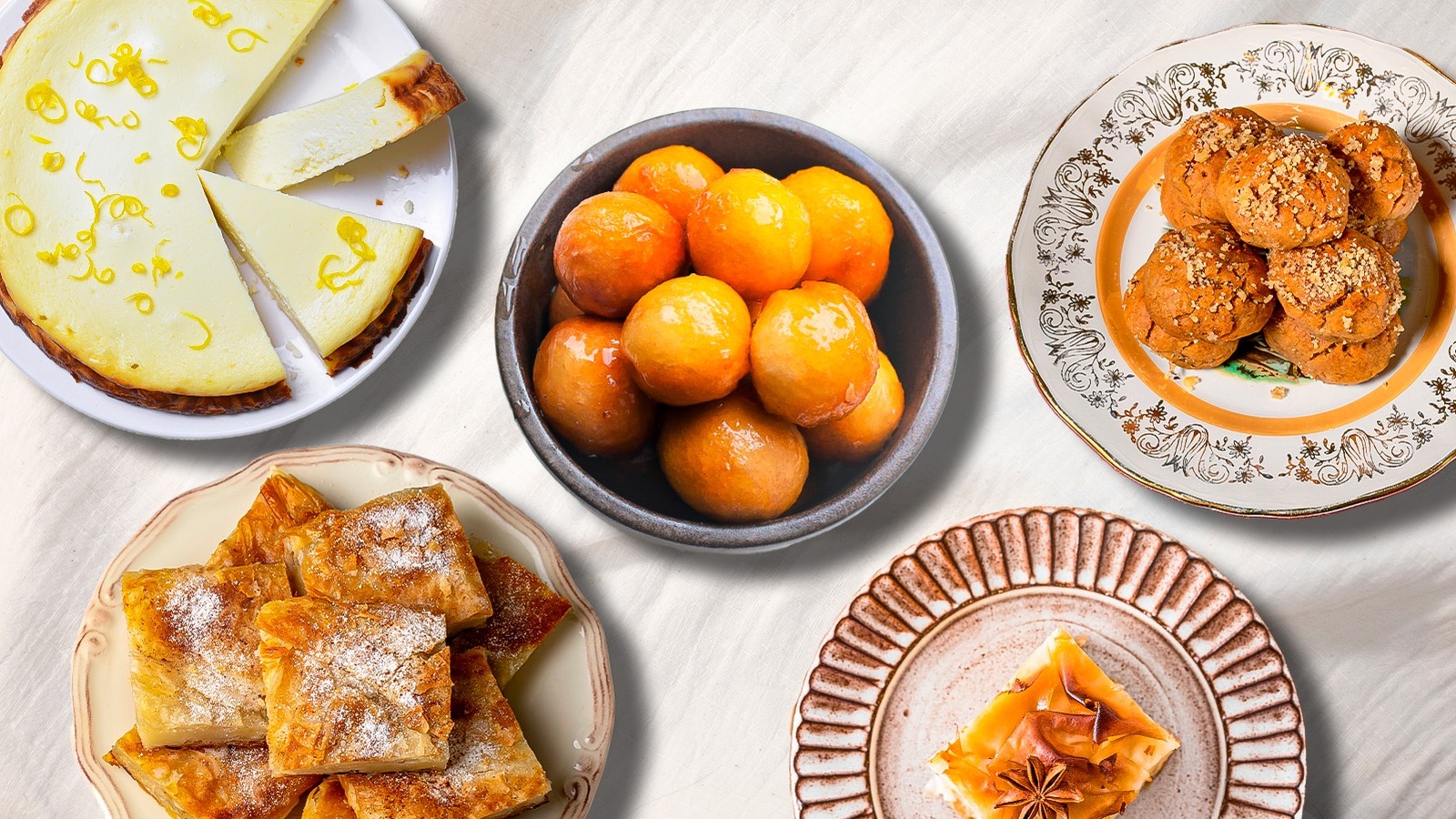When someone says “Greek food,” it’s pretty easy to imagine a slew of savory delights, like Greek salad, skewers of meat, olives, dips, and pita bread. Although desserts are not initially synonymous with Greek cuisine, there are a number of both popular and lesser-known sweets from the country worth trying.
Like any cuisine, Greek pastries and baked goods share similar ingredients and techniques. For example, Greek desserts often feature syrups, nuts, spices, and citrus. The sweets often use simple ingredients, and some of the recipes even date back to ancient times. Not only have these tasty treats sparked joy among eaters for centuries, but they also served as high-calorie foods to sustain Greece’s predominantly rural population, many of whom performed physically demanding work.
We’ve made a list of the desserts worth trying if you find yourself in Greece. While some remain true to their historic origins, others have been refined over the years to create some of the desserts we recognize today.
Baklava
Baklava is perhaps one of the most well-known Greek desserts. It’s made with layers of phyllo dough, chopped nuts, and syrup. Phyllo is unleavened pastry dough that turns crispy and flaky in the oven. In Greek, the word “phyllo” translates to “leaf” — a nod to the pastry’s thinness.
While it’s common to see baklava in Middle Eastern countries, like Turkey and Lebanon, Greek baklava has several identifiable features that make it unique. The Greek preparation often utilizes walnuts, while other kinds of baklava use other types of nuts, like pistachios. Greek baklava also often includes ground cinnamon and honey, the latter of which contributes to the baklava’s notable gloss and makes it sweeter than other regional preparations. You’ll often find it sliced into large triangles, whereas Turkish and Lebanese baklava is often cut into squares, diamonds, cylinders, or sometimes triangles. In Greece, baklava is a bakery and pastry shop staple, but it’s also served on special occasions and during festive seasons.
Galaktoboureko
Galaktoboureko is a Greek custard dessert. Much like baklava, it features phyllo pastry and is soaked in syrup. The custard itself is made from sugar, milk, eggs, butter, vanilla, semolina, and sometimes cream — depending on the recipe. Semolina, a durum wheat flour, is used to thicken the custard and make it creamy. The syrup is typically made from sugar, cinnamon, water, and lemon, though some preparations will also call for honey.
While the name “galaktoboureko” comes from “gala,” the Greek word for milk, it’s possible to make galaktoboureko with dairy-free milk as well. This unctuous dessert is relatively straightforward to make. However, while it might be tempting to dive in once it’s done baking, it’s important to allow it to completely cool so the custard can set properly.
Bougatsa
Bougatsa is a sweet morning pie commonly found at Greek bakeries and pastry shops. It is essentially galaktoboureko’s sister, but without the syrup.
You can eat bougatsa at any time of day, and the absence of syrup makes it more breakfast-friendly than a galaktoboureko. Bougatsa is made with phyllo dough and a vanilla and semolina custard. It’s also common to add orange or lemon zest to the custard for a hint of zingy flavor. Once out of the oven, the flaky phyllo pastry is dusted with powdered sugar and cinnamon. Buttery, creamy, and crunchy — what’s not to love?
Melopita
Cheesecake lovers everywhere will adore melopita. It’s a honey pie — “meli” means “honey” and “pita” means “pie.” This no-fuss, crustless cheesecake originated on the island of Sifnos. Not only is it absolutely delicious, but it’s surprisingly simple to make, requiring only five ingredients: ricotta, eggs, honey, vanilla, and cornstarch (and sometimes sugar, depending on your recipe).
Using a good-quality ricotta and honey can make all the difference in your melopita. Avoid skim milk ricotta because it can impart a gritty texture and impact the structural integrity of the pie. Simply whisk all the ingredients together, pour it into a cake pan, bake for approximately an hour, and let it cool.
Karythopita
Karythopita is a spiced walnut cake. Like other siropiasta desserts, it’s doused with syrup once it comes out of the oven. The syrup — often made from sugar, water, lemon juice, and cinnamon – should be cooled before being poured onto the hot cake. Meanwhile, walnuts are the heart of the cake itself — “karydia” is the Greek word for “walnuts.” The walnuts should be pulsed in a food processor, rather than blended into a powder, as the chunks add texture to the cake. Cinnamon is a must, but it’s also common to add nutmeg, cloves, or cardamom.
If you try this recipe at home, be careful not to over-mix the batter, as you want to keep the cake light and fluffy. Other than that, it’s a pretty foolproof dessert, and if you accidentally over bake your cake, fear not; the syrup will keep it moist!
Loukoumades
Loukoumades are yet another recognizable Greek dessert. This honey-soaked, Greek take on donuts is similar to donut holes, but in true siropiasta fashion, they’re soaked in honey after they’re fried. Loukoumades, then dubbed “honey tokens,” were given to winners of the first Olympics in Ancient Greece. Today, they’re sold by Greek bakeries and street food vendors, or you can even try to make these at home. You can even find loukoumades outside of Greece, including in countries like Turkey, Italy, and Egypt.
These golden brown delights are crunchy on the outside and soft and fluffy on the inside. Besides being covered in honey, they can come with a variety of toppings. A traditional Greek version is chopped walnuts and ground cinnamon, or you can get creative and pair the donuts with melted chocolate, Nutella, or ice cream.
Kataifi
Kataifi refers to both shredded phyllo dough and a dessert, the latter of which features layered, crunchy pastry filled with nuts and drizzled with hot syrup. The exact origin of is unknown, but it’s very popular in Greece, the Middle East, and the Balkan countries.
While kataifi shares similar flavors to other Greek desserts like nuts and syrups, it looks very different. The uncooked pastry looks like angel hair pasta and resembles shredded wheat after it’s baked. The pastry bundles are buttery, decadent, and have a delightful texture.
Like other baked goods, kataifi can be found in Greek bakeries and pastry shops. And if you’re making it at home, you’ll be happy to know that it can keep for upwards of a month in the fridge.
Kourabiethes
Kourabiethes, powdered-sugar-covered almond shortbread cookies, are hugely popular around Christmastime in Greece. You’ll find these in any Greek bakery during the festive season, and they’re easy to bake at home, too. They’re made with pantry staples like eggs, butter, vanilla, all-purpose flour, and baking powder.
The inclusion of fragrant ingredients, like ouzo or rose water, make kourabiethes a bit different from old reliables — like chocolate chip or oatmeal cookies. If you can’t find ouzo, use brandy, and orange blossom water works well in place of rose water. You can also use blanched, toasted, roasted, or slivered almonds.
Rizogalo
While a lot of Greek desserts use doughs and pastry, rizogalo is a bit different. It’s the Greek take on rice pudding, as suggested by its name — “rizo” meaning rice and “gála” meaning milk. The recipe often includes milk, rice, sugar, cinnamon, cornstarch, and vanilla. It’s best to use a short-grain rice, like arborio, because its high starch content ensures a creamy pudding. For an even creamier rizogalo, use heavy cream.
It’s a simple dessert to make, and you can try variations of it. Try adding lemon and orange for a citrusy twist or, adorn the final product with fruit and nuts.
Portokalopita
Portokalopita is a Greek orange cake; “portokáli” means “orange.” Yes, you guessed it — this is a siropiasta! Hailing from Crete, this citrus dessert sets itself apart from its siropiasta friends because of its texture. While most cakes require flour, this one is made with another Greek staple: phyllo. Since it stands in for the flour, it needs to be completely dry before you work with it. It can be air-dried or dried in the oven.
The dry phyllo, eggs, sugar, cream (or yogurt), butter, baking powder, orange juice and zest are combined to create portokalopita. The syrup is made with orange juice and zest, water, sugar, and often a cinnamon stick for extra flavor. Once the cake is cooled, it’s poked with a skewer and covered with the syrup. Portokalopita is delicious on its own, and pairs well with Greek yogurt, cream, or vanilla ice cream.
Pasteli
Pasteli is a sesame and honey bar that may have originated as far back as the 3rd century. This snack is so common that you might not even realize that it’s Greek. In fact, you can find packaged versions of this snack both in Mediterranean delis, bakeries, supermarkets, and in U.S. stores. And it’s no wonder why — they’re simple and delicious. Pasteli requires only a few ingredients: sesame seeds, sugar, honey, and almonds, though other nuts are often substituted. Like most Greek desserts, it’s typical to see versions with additional spices or citrus.
There are many variations of this treat, and the exact recipe can vary. Different islands and regions heat the honey different ways, use different ratios of honey and sesame, or may make crunchier or chewier versions.
Diples
Diples, another siopiasta, hail from the Peloponnese. They are a fried pastry made from thin, folded dough. Once fried, they’re covered with honey syrup and walnuts. Diples get their name from the Greek word “diplono,” meaning “folding,” which accurately describes their appearance. The dough is easy enough to make, as it is made up of standard ingredients. If you try to make them at home, try using a pasta machine instead of a rolling pin. You’ll also want to work quickly, as you’ll need to shape and fold the dough in the hot oil.
Diples are a culinary delight and are treated as such. They’re super popular in Greece around Christmastime and are also served at weddings, as it’s thought that the number of folds represent the blessings a couple will receive.
Vasilopita
Vasilopita is a ceremonial cake typically cut at midnight on New Year’s Eve to ring in the New Year. “Vasilopita” translates to “sweet bread of Saint Basil” — a nod to Saint Basil, who is celebrated for his generosity. Traditionally, something small, typically a coin, is baked into the cake, and it’s thought that whoever finds it in their slice will have a good fortune for the coming year.
Vasilopita is made with standard cake ingredients — flour, eggs, butter, sugar, vanilla — in addition to beloved Greek flavors like orange, brandy, and almonds. You can even add Greek yogurt to the batter to make it extra soft and fluffy. The cake is iced with a sugar glaze or dusting of icing sugar, and can be decorated with whatever you fancy.
Melomakarona
The Greeks love syrup-soaked desserts — including melomakarona. Melomakarona are cookies soaked in honey syrup; makarona comes from the Greek word “makaria” meaning “blessed.” Unlike a lot of cookie recipes, melomakarona call for olive oil instead of butter. The other ingredients are sugar, orange juice, honey, cognac or brandy, and spices like cinnamon or cloves, though some recipes also call for semolina. In addition to being soaked in the honey syrup, it’s traditional for melomakarona to be covered with chopped walnuts.
Melomakarona are a Greek Christmas treat, and the absence of egg and dairy in the recipe means they can be enjoyed by those who are fasting. This delicious baked good showcases many of the ingredients and flavors Greece has to offer.





